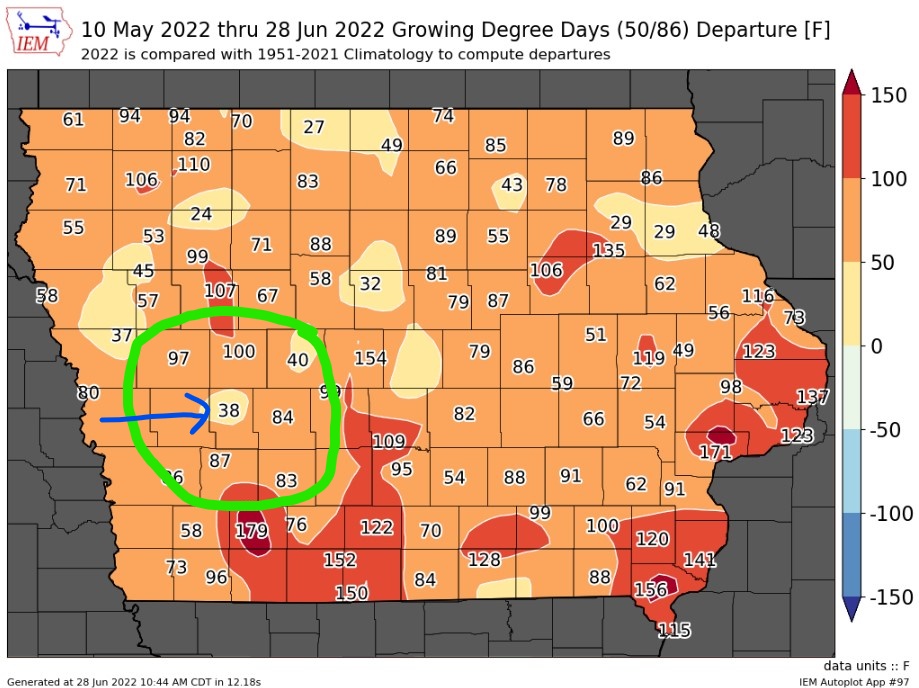July 1st, 2022
posted
by Andrew Blomme on 7/1/2022
in
Weekly Newsletter

July 1st, 2022
There has been a lot of action in the fields recently. This update will cover some of the observations Lou and I have made over the last week as we have been scouting the area's corn and soybean fields. This crop is really starting to progress along rapidly and some of the factors we will discuss today will have some impact on the crop later in the season.
1. GDU Accumulation
Get ready for the understatement of the year: This corn crop is growing fast! This month has been in the top 25% hottest Junes on record. In just the last 10 days we have accumulated close to 250 GDU's. Before a corn plant gets to V10, it takes roughly 84 GDU's for each new leaf to develop. After V10, a stage which many fields are past, it takes roughly 54 GDU's for each new leaf. In the past 10 days the corn crop has progressed through 3-5 growth stages.
We are way ahead of schedule for GDU accumulation so far this growing season. The map below shows that our area is roughly 80-100 GDU's above average for the time period of May 10th to June 28th. That is about 4 full days' worth of GDU's that we are ahead of schedule for this corn crop. For everyone that planted fuller season corn hybrids after May 10th, myself included, Mother Nature is helping us out so far. I want to quickly denote that the data collection center for Audubon, shown by the blue arrow, is not very representative for what is actually occurring in the area. Just be aware of that as you look at the map.

2. Soybean Gall Midge
This pest is back again this year. I have written about soybean gall midge several times in 2020 and 2021. Rather than repeat myself, the following link will take you to one of these posts that covers soybean gall midge in depth: Herbers Seed-August 28th, 2020.
Lou and I have witnessed this pest every year for the past 3 years. It is noticeably more prevalent this year compared to years past. There are several generations, or lifecycles, of this pest in a single growing season. It is expected that subsequent generations will cause more damage.
This leads to the question, what can we do to control these things? That is a good question with very few good answers. Iowa State, Minnesota, and Nebraska have teams researching this pest to develop control methods. The biggest hurdle in this pursuit is that no one has found a way to grow soybean gall midges in a lab setting. As such, there is a very limited number of "at bats" every year to test out different control methods. The best (depends on your definition of best) practice so far is applying Thimet, a granular insecticide, at planting. The practicality of that solution is lacking for the majority of operations in our area at the moment. Over the top insecticides can kill the adult midges but are not effective at killing the larva feeding on the plant. We learn more every year, but there is still more out there to figure out about this pest.
3. Sins of the Planter
There is a lot of sidewall compaction and sidewall smear in fields from this spring. I think we can all agree that this spring soil conditions were not ideal and there were spots that were planted that were very challenging. We are already seeing some consequences of that.
Sidewall compaction limits corn root growth except along and directly below the seed furrow. This restricts water and nutrient uptake and creates a weak anchor point for the corn plant as it grows upward. Wind storms in late July/August/September are common in our area (think derecho in August 2020). If, and more likely when, we catch one of these storms, we will see some lodged corn. We will see hybrids that stood through the derecho, get blown over this year because of sidewall compaction. Fingers crossed for a gentle second half of the growing season.
What To Look For In The Future
This corn crop is developing really fast. Even with the relatively slow spring I expect to see corn tassels around July 9-10th. With that, we are only a short 2 weeks away from the peak of fungicide application. The decision to spray fungicide will be here quickly, so start thinking about it now.
I will looking for corn rootworm larva and rootworm damage in corn on corn fields over next week. Rootworm hatch started during the 1st week of June so they have been feeding for several weeks now. We had a record high number of rootworm last year, I hope to see less this year. I expect to see soybean gall midge to continue to show up in more field edges in the coming days as well. I will update you guys on my observations in next week's newsletter.